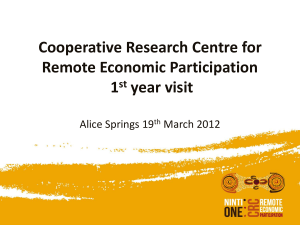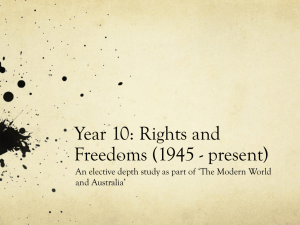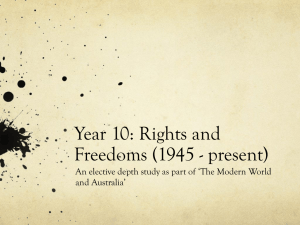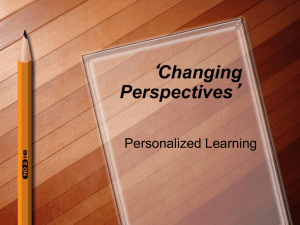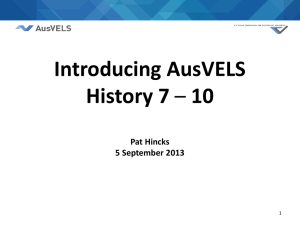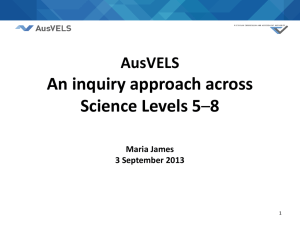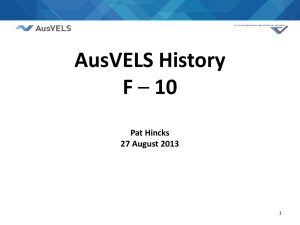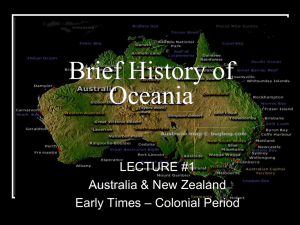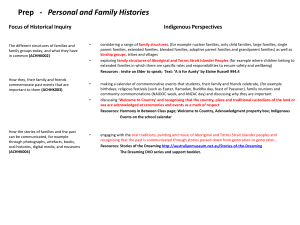AusVELS History Primary - Victorian Curriculum and Assessment
advertisement
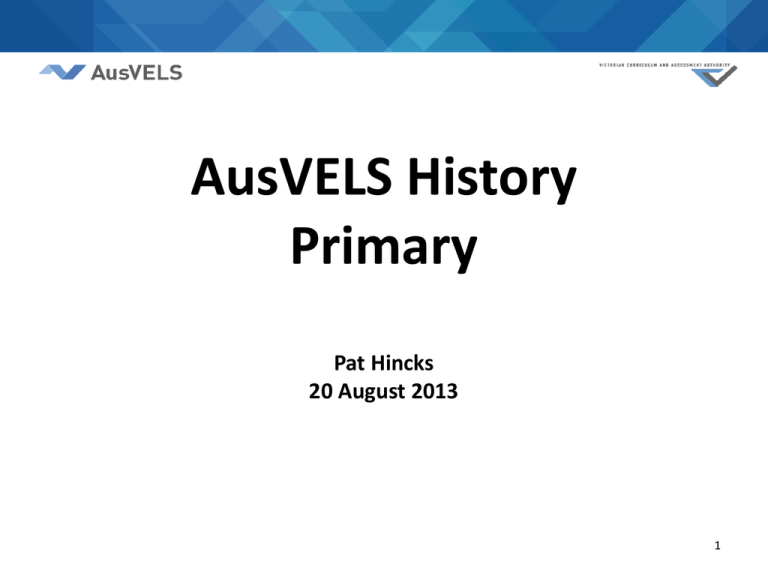
AusVELS History Primary Pat Hincks 20 August 2013 1 Primary History: Common questions • • • • • Is there a mandated time? Does it have to be taught for a whole year? What is the status of the elaborations? What about multi-age/ composite classes? Can we ‘integrate’ history with other subjects? • How can we fit it into a ‘crowded curriculum’? 2 History and time allocation There is no time allocation which is mandated for AusVELS History. However: History F – 2 was written for 20 hours a year History 3 – 6 was written for 40 hours a year History 7 – 10 was written for 50 hours a year Source: Curriculum Design Paper, ACARA, http://www.acara.edu.au/curriculum/curriculum_design_and_development.html 3 Humanities and Social Sciences Curriculum History Geography Civics and Citizenship Economics and Business F-2 20 hours per year 20 hours per year NIL NIL 3-4 40 hours per year 40 hours per year 20 hours per year NIL 5-6 40 hours per year 40 hours per year 20 hours per year 20 hours per year 7-8 50 hours per year 50 hours per year 20 hours per year 20 hours per year 9-10 50 hours per year 50 hours per year 20 hours per year 50 hours per year 4 ‘Integrating’ content • We are not re-creating SOSE! • Curriculum content can be meaningfully put together based on a particular context or theme. • Eg: Obvious links with geography – local history and geography • Eg: text selection in English e.g. The Rabbits might lead to history of settlement of Australia. 5 6 History: Structure AusVELS History Explanations Level Descriptions a) Overview of the Level Content b) Key concepts of history understanding c) Key inquiry questions a) What will be taught in that level b) Continuity and change, cause and effect, perspectives, empathy and significances, Sources c) Inquiry questions frame teaching and learning for that year Content Descriptions a) Historical knowledge and understanding b) Historical skills Knowledge and understanding strands are year by year Historical skills strands are in a three level band from F – 2 and then in two level bands Achievement Standards Focus on understanding and skills Describe what students know and can do at each level 7 Historical sequence Level Content Level F Personal and Family Histories Level 1 Present and Past Family Life Level 2 The Past in the Present The Foundation curriculum provides a study of personal and family histories. Students learn about their own history and that of their family The Level 1 curriculum provides a study of present and past family life within the context of the students’ own world. The Level 2 curriculum provides a study of local history. Concepts of historical understanding continuity and change, cause and effect, perspectives, empathy and significance Key questions What is my history and how do I know? What stories do other people tell about the past? How can stories of the past be told and shared? How has family life changed or remained the same over time? What aspects of the past can you see today? What do they tell us? How can we show that the What remains of the past are present is different from important to the local or similar to the past? community? Why? How do we describe the sequence of time? How have changes in technology 8 shaped our daily life? Level Content Level 3 Community and Remembrance Level 4 First Contacts The Level 3 curriculum provides a study of identity and diversity in both a local and broader context…. students explore the historical features and diversity of their community as represented in symbols and emblems of significance, and celebrations and commemorations… The Level 4 curriculum introduces world history and the movement of peoples. Beginning with the history of Aboriginal and Torres Strait Islander peoples, students examine European exploration and colonisation in Australia and throughout the world up to the early 1800s. Concepts of historical understanding sources, continuity and change, cause and effect, perspectives, empathy and significance. Key questions Who lived here first and how do we know? Why did the great journeys of exploration occur? How has our community changed? What features have been lost and what features have been retained? What was life like for Aboriginal and/or Torres Strait Islander Peoples before the arrival of the Europeans? Why did the Europeans settle in Australia? What is the nature of the contribution made by different groups and individuals in the community? How and why do people choose to remember significant events of the past? What was the nature and consequence of contact between Aboriginal and/or Torres Strait Islander Peoples and early traders, explorers and settlers? 9 Level Content Level 5 The Australian Colonies Level 6 Australia as a nation Level 5 curriculum provides a study of colonial Australia in the 1800s. Students look at the founding of British colonies and the development of a colony. Level 6 [covers] the development of Australia as a nation, particularly after 1900. Students explore the factors that led to Federation and experiences of democracy and citizenship over time…. Students learn about the way of life of people who migrated to Australia and their contributions…. Concepts of historical understanding sources, continuity and change, cause and effect, perspectives, empathy and significance. Key questions What do we know about the lives of people in Australia’s colonial past and how do we know? How did an Australian colony develop over time and why? How did colonial settlement change the environment? What were the significant events and who were the significant people that shaped Why and how did Australia become a nation? How did Australian society change throughout the twentieth century? Who were the people who came to Australia? Why did they come? What contribution have significant individuals and groups made to the development of Australian society? 10 Historical understanding • Continuity and change: aspects of the past that remained the same over certain periods of time and aspects that are different • Cause and effect used by historians to identify chains of events and developments over time and includes understanding of motivation and consequences • Perspectives: understanding the different social, cultural and intellectual contexts that shaped people’s lives and actions in the past and the various viewpoints on past events. 11 Historical understanding • Empathy is an understanding of the past from the point of view of a particular individual or group, including an appreciation of the circumstances they faced, and the motivations, values and attitudes behind their actions • Significance the importance that is assigned to particular aspects of the past, eg events, developments, movements and historical sites. Why do we remember some parts of the past and not others? • Sources – evidence of the past including artefacts, photos, artworks, letters etc (Commonly primary and secondary) 12 Elaborations 13 Skills F-2 3-4 5-6 Sequence historical people and events Use historical terms Sequence historical people and events Use historical terms and concepts Pose a range of questions about the past Identify questions to inform an historical inquiry Identify and locate a range of relevant sources Locate relevant information from sources provided Locate information related to inquiry questions in a range of sources Compare information from a range of sources Identify different points of view Identify points of view in the past and present Develop a narrative about the past Develop historical texts, particularly narratives Develop historical texts, particularly narratives and descriptions, which incorporate source material Use a range of communication forms (oral, graphic, written, role play) and digital technologies Use a range of communication forms (oral, graphic, written) and digital technologies Chronology, terms and concepts Sequence familiar objects and events Distinguish between the past, present and future Historical questions and research Pose questions about the past using sources provided Analysis and use of sources Explore a range of sources about the past Identify and compare features of objects from the past and present Perspectives and interpretations Explore a point of view Explanation and communication Use a range of communication forms (oral, graphic, written) and digital technologies 14 Achievement standards • Level by level • Two paragraphs 1) understanding 2) skills • Designed to answer the question: What do I want students to know and be able to do at this level? • Used with the content descriptions to plan curriculum. The Knowledge and understanding and Skills strands provide the content that allows students to reach the standards. 15 Historical Knowledge and Understanding Level 5 The Australian Colonies • Reasons (economic, political and social) for the establishment of British colonies in Australia after 1800. (ACHHK093) • The nature of convict or colonial presence, including the factors that influenced patterns of development, aspects of the daily life of the inhabitants (including Aboriginal Peoples and Torres Strait Islander Peoples) and how the environment changed. (ACHHK094) • The impact of a significant development or event on a colony; for example, frontier conflict, the gold rushes, the Eureka Stockade, internal exploration, the advent of rail, the expansion of farming, drought. (ACHHK095) • The reasons people migrated to Australia from Europe and Asia, and the experiences and contributions of a particular migrant group within a colony. (ACHHK096) • The role that a significant individual or group played in shaping a colony; for example, explorers, farmers, entrepreneurs, artists, writers, humanitarians, religious and political leaders, and Aboriginal and/or Torres Strait Islander peoples. (ACHHK097) 16 Historical Skills Level 5 Chronology, terms and concepts • Sequence historical people and events (ACHHS098) • Use historical terms and concepts (ACHHS099) Historical questions and research • Identify questions to inform an historical inquiry (ACHHS100) • Identify and locate a range of relevant sources (ACHHS101) Analysis and use of sources • Locate information related to inquiry questions in a range of sources (ACHHS102) • Compare information from a range of sources (ACHHS103) Perspectives and interpretations • Identify points of view in the past and present (ACHHS104) Explanation and communication • Develop texts, particularly narratives and descriptions, which incorporate source materials (ACHHS105) • Use a range of communication forms (oral, graphic, written) and digital technologies (ACHHS106) 17 Level 5 Achievement Standard By the end of Level 5, students identify the causes and effects of change on particular communities, and describe aspects of the past that remained the same. They describe the different experiences of people in the past. They describe the significance of people and events in bringing about change. Students sequence events and people (their lifetime) in chronological order, using timelines. When researching, students develop questions to frame an historical inquiry. They identify a range of sources and locate and record information related to this inquiry. They examine sources to identify points of view. Students develop, organise and present their texts, particularly narratives and descriptions, using historical terms and concepts. 18 AusVELS Resources and Support http://www.vcaa.vic.edu.au/Pages/foundation1 0/curriculum/index.aspx Under History menu • Summaries of differences between AusVELS and VELS • Planning templates • Progression Points 19 Progression point examples • Assist teachers in the assessment and reporting of student achievement. • In AusVELS, the progression point examples are provided in 0.5 increments. Progression point examples are designed to: Progression point examples are NOT designed to: • illustrate how a student might show evidence of progression • be used in conjunction with other tools such as annotated student work samples • be modified by schools so that the examples reflect the curriculum structure and timing of when knowledge and skills are taught and assessed • replace standards • be used as a definitive or mandated set of progression measures for student assessment • be the only resource used by teachers to assign progression points on student reports 20 Select aspect of content descriptions Develop assessment tasks that will allow students to demonstrate aspects of achievement standards 21 Further resources • Scootle: www.scootle.edu.au – Can search on year levels and each dot point in the Knowledge and understanding and Skills strand. – Contains interactive resources/images/ collections/film clips/education packs/TL resources • History Teachers’ Association of Australia: http://www.historyteacher.org.au/ 22 Primary History: Common questions • • • • • Is there a mandated time? Does it have to be taught for a whole year? What is the status of the elaborations? What about multi-age/ composite classes? Can we ‘integrate’ history with other subjects? • How can we fit it into a ‘crowded curriculum’? 23 Victorian Curriculum and Assessment Authority (VCAA) www.vcaa.vic.edu.au Pat Hincks Humanities and Social Sciences Curriculum Manager hincks.patricia.m@edumail.vic.gov.au 24

